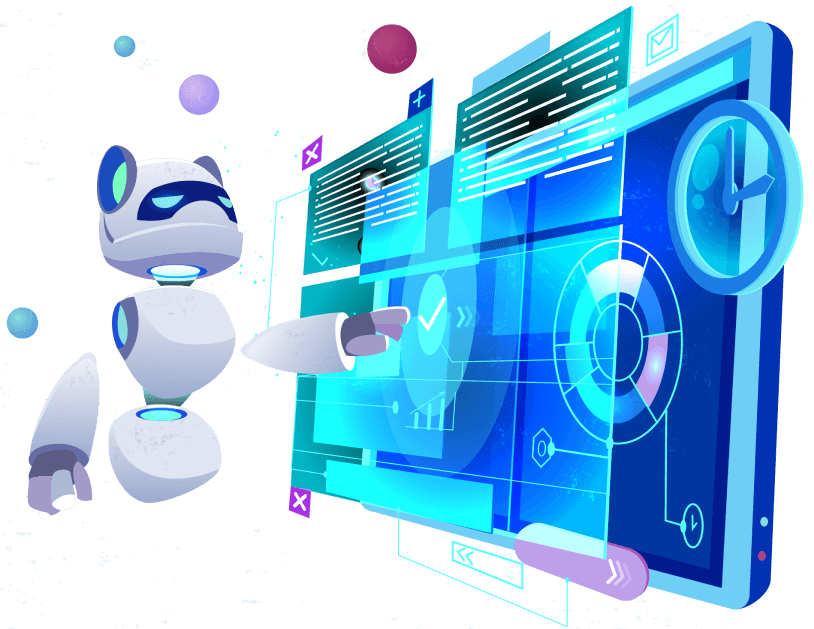Data Analytics
We transform raw data into actionable insights by employing sophisticated data mining techniques.

Artificial intelligence (AI) is perceiving, synthesizing, and inferring information—demonstrated by , as opposed to intelligence displayed by n and . Example tasks in which this is done include speech recognition, computer vision, translation between (natural) languages, as well as other mappings of inputs. The of defines artificial intelligence as:




In today's data-driven world, businesses are amassing vast amounts of information. Extracting meaningful insights from this data is crucial for making informed decisions, gaining a competitive edge, and driving innovation. At InnovaMind, we empower businesses to harness the power of data and artificial intelligence (AI) with our comprehensive suite of services.

We transform raw data into actionable insights by employing sophisticated data mining techniques.

We develop intelligent machine learning models that learn from data and make predictions or decisions.

We craft bespoke AI solutions tailored to your unique business challenges and objectives.



AI is the broader concept of machines being able to carry out tasks in a way that would normally require human intelligence.

A smart virtual assistant powered by AI can be a valuable asset for businesses of all sizes. Here are some of the benefits of using a smart virtual assistant for customer
Read More arrow_right_alt
We enable fashion brands and retailers to deliver personalized styling experiences at scale with cutting-edge AI fashion styling services
Read More arrow_right_alt
Revolutionize your website's meta information,description,content with AI-powered automation. Our intelligent system analyzes your content
Read More arrow_right_alt
Introducing InnovaMind’s innovative Smart Search, an AI-powered search feature that empowers customers to find the products they desire with effortless ease.
Read More arrow_right_alt
Our AI chatbots are available around the clock to answer customer questions, ensuring timely support regardless of the hour.
Read More arrow_right_alt
AI social media response tool takes the burden off your shoulders by automatically responding to customer comments and messages on your social media channels
Read More arrow_right_alt



AI is the broader concept of machines being able to perform tasks that would normally require human intelligence, such as visual perception, speech recognition, and language translation.

The journey begins with data. This data can come from various sources like customer interactions, sensor readings, social media, or internal databases.

The collected data is securely stored and organized. We utilize robust data warehousing solutions to ensure its accessibility and integrity.

Not all data is created equal. Our system performs meticulous cleaning and pre-processing to eliminate inconsistencies, missing values, and format variations. This ensures the data is ready for analysis.

The beauty of our system lies in the seamless integration of AI and ML. The AI supervises the overall process, selecting the most appropriate algorithms and optimizing performance.





Artificial intelligence, or AI, is the simulation of human intelligence in machines that are programmed to think and learn...
AI (Artificial Intelligence): The broader concept of machines mimicking human cognitive functions like learning, problem-solving, and decision-making. It encompasses various techniques, including machine learning. ML (Machine Learning): A subfield of AI that focuses on algorithms that learn from data without explicit programming. These algorithms improve their performance over time as they are exposed to more data. Analogy: Think of AI as a toolbox containing various tools for intelligent behavior. Machine learning is a powerful tool within that toolbox that allows machines to learn and improve from data.
AI: Virtual assistants, self-driving cars, facial recognition, spam filtering, robotic process automation. ML: Recommendation systems (e.g., Netflix, Amazon), fraud detection, stock market prediction, medical diagnosis, image and speech recognition.
Learn the basics: Take online courses, read books, or attend workshops to understand core concepts. Many platforms offer introductory courses in AI and ML. Practice with coding: Platforms like TensorFlow, PyTorch, and scikit-learn provide beginner-friendly tools for experimentation. Start with simple projects to solidify your understanding. Explore online resources: Numerous websites and communities offer tutorials, code examples, and discussions related to AI and ML.
Technical skills: Programming languages (Python, R), data analysis skills (statistics, data manipulation), machine learning algorithms, deep learning concepts (optional).
Problem-solving skills: The ability to identify problems that can be addressed with AI/ML and develop solutions.
Analytical thinking: Skills to interpret data, identify patterns, and draw meaningful insights.
Increased efficiency: Automate repetitive tasks, improve decision-making processes, and optimize workflows.
Enhanced customer experience: Personalize interactions, provide targeted recommendations, and offer better customer support.
Improved product development: Gain insights from customer data to develop innovative products and features.
Reduced costs: Automate tasks, optimize operations, and gain a competitive edge.
Data dependency: The quality and quantity of data significantly impact performance.
Explainability: Some complex models can be difficult to interpret, making it challenging to understand their reasoning.
Bias: AI models can perpetuate biases present in the data used to train them. Careful selection and pre-processing of data is crucial.
Ethical considerations: Issues like job displacement and privacy concerns need to be addressed as AI and ML become more prevalent.

